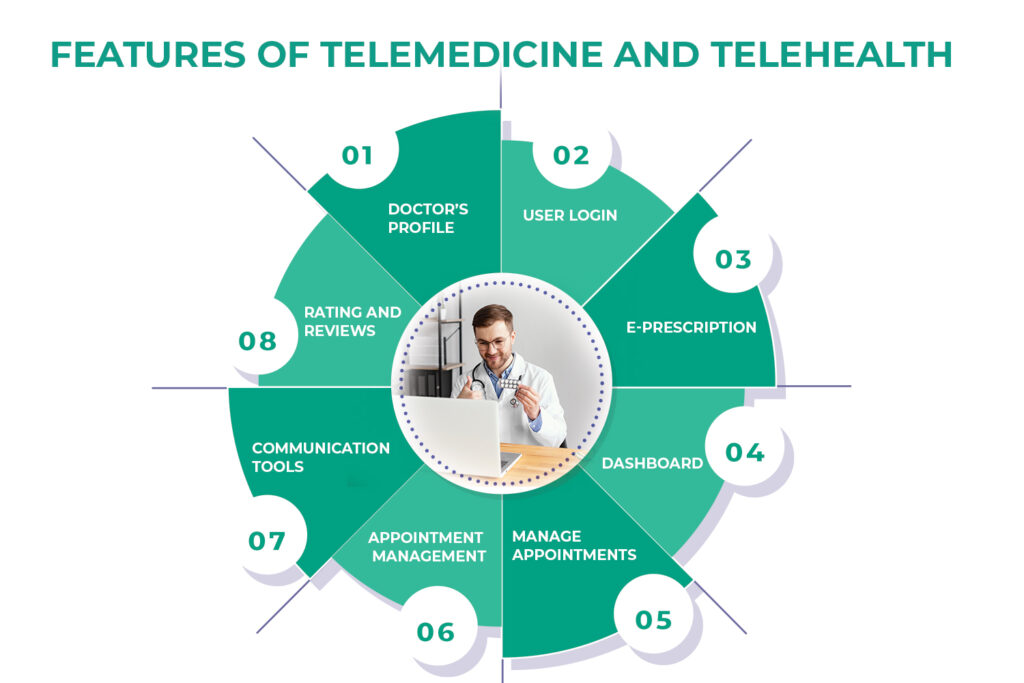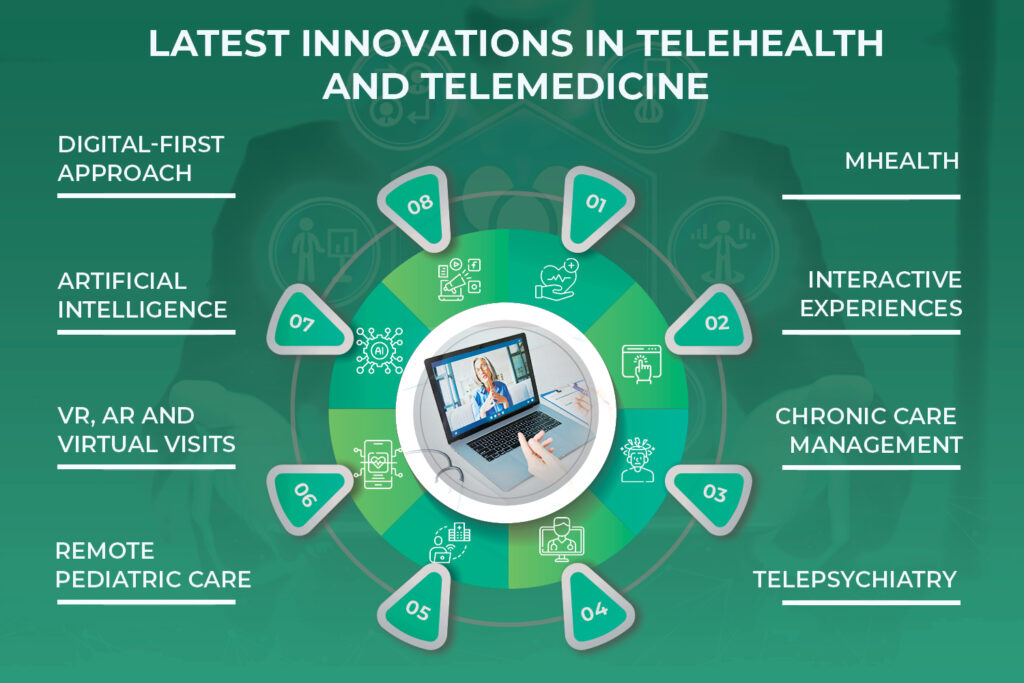Future of Telehealth and Telemedicine: Exploring the Latest Software Innovations
The sudden outburst of COVID-19 locked everyone inside their homes, even if there was a medical emergency. During this time, the use of telehealth and telemedicine technology increased, which allowed patients to receive quality healthcare services in the comfort of their homes. Now, the world has overcome the fear of COVID-19; however, the dependence on the telemedicine industry is also increasing because of its benefits and features. Still, some people are unsure of the future of telehealth and telemedicine.
If you are one of them, you’ve landed on the right page. This article is a complete guide on the future of the telehealth and telemedicine industry along with all the latest innovations or trends related to telehealth vs telemedicine. So, without any delay, let’s dive in!
Telehealth and Telemedicine: Overview
Telehealth refers to a process of using communication technologies and digital information to access all renowned healthcare services online or remotely. Technologies include desktop and computer devices like smartphones, tablets, and more, through which doctors and patients connect and discuss problems. Also called as m-health or e-health, their major aim is to make medical services accessible to all.
The scope of telehealth is limited to remote patient monitoring, mental health support, provider training, continuing medical education, public health education, administrative meetings, and electronic information sharing.
Telemedicine refers to using technology to offer excellent treatment solutions from a distance. Healthcare experts and patients communicate and discuss underlying health problems on telemedicine applications. Telemedicine software has improved access to healthcare services in rural areas.
These services include medication adherence, social support, patient health education, and troubleshooting health problems.
Although both terms, including telehealth and telemedicine, are used interchangeably, one significant difference between them is that telemedicine majorly deals with remote medical services. Telehealth is also related to medical and non-medical services. Thus, medicine is known to be a part of telehealth.
Features Of Telemedicine And Telehealth
Here are some standard features of telemedicine and telehealth:

1. Doctor’s Profile
When the healthcare experts register on the telemedicine application, it displays their experience, expertise, license, specialization, and other details. Besides this, the doctor’s profile also includes a calendar with appointments.
2. User Login
User login or the patient’s registration is another vital feature of the telemedicine application. Every time a user signs up for the telemedicine app, all critical information, including the patient’s age, name, sex, health condition, and more, is mentioned.
3. E-prescription
E-prescription is an important feature that benefits patients, doctors, and pharmacies by speeding up healthcare services. Doctors can easily produce e-prescriptions and send them without errors through the e-prescription feature.
4. Manage Appointments
The Telemedicine app includes calendar integration, making it easier for doctors and patients to manage their appointments automatically.
5. Communication Tools
On the telemedicine app, a must-have feature is the communication tool that patients and healthcare experts can use to video-conference or call to talk to one another.
6. Rating And Reviews
On your telemedicine app, patients can rate experiences and add reviews based on their likings. It allows all patients to express their feelings about a particular service and rate a doctor based on their experience.
7. Dashboard
A dashboard present on a Telemedicine software is meant for doctors and patients where important information like the total number of visits, doctors’ recommendations, current prescriptions, appointment details and other essential information is mentioned. This makes it easier to understand and follow everything.
8. Appointment Management
Another most important feature of the telemedicine app is the appointment management feature feature. Using this feature, doctors, nurses or other healthcare professionals can schedule patients for regular visits, telehealth exams, recurring appointments, seasonal vaccinations and follow-up consultations.
Latest Innovations in Telehealth and Telemedicine
Some of the latest innovations in telehealth and telemedicine:

1. Digital-first Approach
When adopting digital technologies, the healthcare industry is comparatively slower than most industries. However, the spread of coronavirus made it more accessible as telehealth and telemedicine software came into the limelight and medical services shifted to online mode, which was the need of the hour. Since then, most hospitals and companies have invested in telemedicine software to boost this technology.
2. mHealth
In the medical industry, mHealth is evolving as a game changer, allowing doctors or health professionals to offer people excellent healthcare services at affordable prices. Today, several mHealth applications have captured the healthcare market. Above all, the pandemic gave the much-needed push by making healthcare accessible to all patients.
3. Artificial Intelligence
Artificial Intelligence, or AI, has become the talk of the 21st century, and its effects are seen in the medical industry as well. As the medical sector is transforming at a rapid speed, telehealth technology is becoming an integral part of the AI family. The application of artificial intelligence in medicine and healthcare is helping medical experts and doctors get real-time information and make informed decisions. Additionally, AI robots are guided to give patients medication without any reminders, making things easier.
4. Interactive Experiences
Because of integrated medical devices, patients can make decisions regarding their health plans today. Above all, doctors and other medical experts are continuously looking for ways to improve. Because of digital wearables and trackers, patients can share their information with doctors virtually, ensuring they get the best medical services possible.
5. VR, AR and Virtual Visits
Virtual and augmented reality, or VR and AR, are two popular technologies entering the telehealth and telemedicine world. Their applications are great for both healthcare experts as well as patients. Currently, clinics and hospitals worldwide are using virtual reality, which helps educate emerging medical professionals or experts through everyday simulations. Patients prefer virtual visits as they save time and energy and are cost-effective compared to in-person visits.
6. Chronic Care Management
Chronic diseases such as kidney disease, heart disease, cancer, lung disease, Alzheimer’s, diabetes, stroke side effects, and more are becoming common worldwide due to bad lifestyle and eating habits. Patients experiencing these problems do not visit doctors regularly, resulting in a gap in treatment. Through telemedicine and telehealth, you can rely on remote consultation that keeps you committed to the treatment. Additionally, it saves cost and time.
7. Remote Pediatric Care
Since the coronavirus came into existence and its spread, pediatric care has evolved as an essential part of the telehealth industry. Although analyzing children’s symptoms via video conferencing is a tough procedure, several amendments have been made to make this procedure easier. With more innovation and investments, pediatric care through telemedicine will evolve worldwide.
8. Telepsychiatry
Stress, tension, and anxiety can result in depression and depressive disorders in adults. Therefore, such patients always need remote mental health care so that their health remains in check. Mental health experts and psychologists can now include telehealth and telemedicine treatment options. Experts can provide timely solutions to people experiencing these issues through telemedicine software.
Statistics of Telehealth and Telemedicine
- In 2022, the size of the telemedicine industry worldwide was calculated to be USD 87.41 billion. As per the latest reports, this number will rise from USD 94.44 billion in 2023 to USD 286.22 billion by 2030.
- As per today, India is experiencing a massive popularity of telemedicine technology. As a result, it is estimated that the market is going to increase by $5.15 billion in 2030.
- Before the COVID-19 pandemic, only 13% to 17% of American patients used telehealth technology. However, today, the use of virtual care is 38 times greater.
- As per Rock Health’s report, more than 80% of consumers have used telemedicine and telehealth technologies or software at least at least once.
- 75% of people in rural areas are using this software to get timely medical help from experts all around the globe.
- As per GlobalMed, over 74% of people aged between 27 and 42 prefer telemedicine software to in-person meetings because it saves time.
Looking for a White-label Telemedicine Software?
Future of Telehealth and Telemedicine: Is it really promising?
The widespread adoption of telehealth and telemedicine is not hidden anymore. These technologies offer several exceptional advantages to patients and doctors alike, making them a popular choice amongst all. Over the years, telemedicine has evolved as a convenient, cost-effective, and time-saving way to get excellent medical treatments and solutions. It offers a wide range of advantages including making healthcare accessible easily, enhancing public health, providing timely medical solutions, helping to reduce financial pressure, and more. Although this software gained popularity during the pandemic, they are here to stay forever!
VCDoctor FAQs
1. List the top most important features of VCDoctor telemedicine software
Some of the most essential features of VCDoctor telemedicine software are:
- Access to the doctor’s profile
- Electronic medical records and patient’s history
- appointment management
- remote patient monitoring or RPM module
- E-prescription
- Video conferencing
- Internal data exchange
- Profile page and Dashboard for the patients
- Symptom checker
2. List significant benefits of telemedicine software
Some potential benefits of using telemedicine platforms like VCDoctor include access to specialists, cost-effective options, medical access for rural populations, saving time and energy, emergency care, physical therapy at home, no paperwork, and more.
3. What is the Cost of Building a Telemedicine Software?
On average, a professional charges between $30,000 to $40,000 to build your telemedicine software or application. Note that this cost fluctuates based on chosen features and complexity.
4. Mention the step-by-step procedure to build an excellent telemedicine application
Here is the step-by-step procedure to build an excellent telemedicine application:
- The first step is to check your app idea
- Get in touch with best telemedicine platform like VCDcotor for a quotation
- Build a project opportunity for the MVP
- Kickstart the development phase
- Application demonstration approval
- Submit your application to the app store
5. What factors should you consider while choosing a telemedicine app builder company?
Some significant factors to consider while choosing a telemedicine app builder company are the company’s overall experience checking if the company and professionals are using the latest tools and technologies. Check if your potential app development company complies with health and regulatory security standards. Also, see if they offer customizable services and more.
6. How is the cost of building telemedicine software determined?
To determine the cost of building telemedicine software, several factors are considered, including design, application features, mobile development, web development, maintenance, project management, and types of apps.
Wrapping Up!
Ever since the COVID-19 pandemic, there have been several emerging trends that have amplified telehealth and telemedicine software, resulting in unmatched growth and development. Today, patients and doctors are adopting these technologies at a massive level due to the advantages that they offer, like making healthcare services more accessible and economical and saving a lot of time.
The best part is that the entire rural population can get excellent healthcare services in the comfort of their homes. Although telemedicine and telehealth cannot replace the traditional healthcare model, they provide an extra positive layer that promises greater solutions. At VCDoctor, you can get expert solutions easily!




